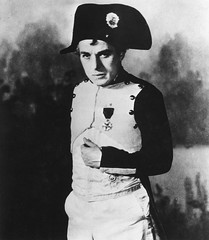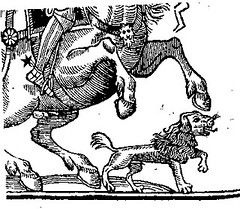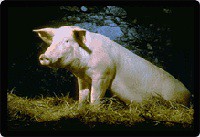January 9th, 2008
Since adopting our first standard poodle a little over 20 years ago – and being Poodle People ever since – we’ve heard a lot of stories about poodles, poodle history and poodle talents from a lot of different people. One of my favorites has to do with how poodles came to be the National Dog of France. No, it wasn’t because poodles are so fashionable or even that they’re so fancy. And it wasn’t because poodles are such fine waterretrievers and hunting dogs who aren’t the least bit gun shy.

As I recall the story (no, I don’t recall who told it to me), it has to do with Napoleon Bonaparte and his strong martial proclivities. Dogs had long been mascots and soldiers in war, from the time of the Vikings and the early Teutonic wars, primarily wolfhounds and other largebreeds. When guns and artillery became standard noisemakers on the battlefields, dogs who would not be shy of the booms or the fire were kept. Among these were the poodle, and Napoleon liked his poodles big.
Known for fierce loyalty, fearlessness and intelligence, the war poodles were known to take part in battles on behalf of their regiments even without specific training for the task. In his memoirs Napoleon praised a poodle who died at the battle of Marengo, licking the face of his fallen Grenadier master. Another poodle named Buff accompanied Lt. Col.Chestmaster during the Peninsula War, while the poodle Moffino got sadly separated from his master while crossing the Berezina River in the Russian campaign. Moffino then traveled from Russia to Italy to find his corporal master, and they were gladly reunited.
One of Napoleon’s enemies, the Duc d’Enghein, took his poodle Mohiloff – a gift from the king of Sweden – with him to prison at the fortress of Vincennes. The dog stayed with his master even as he was shot at dawn and had to be forcibly removed from his grave. The commander of Vincennes adopted Mohiloff, and had him stuffed after he died. A poodle named Moustache became the mascot of a regiment of grenadiers whose standard the dog rescued from the battlefield at Austerlitz. He is also credited with detectiing an Austrian spy and saving a detachment of his company from a surprise attack.

There are many more stories of poodles as war dogs in the Napoleonic campaigns, but the way it was told to me, they actually served in the infantry! Napoleon was a brilliant artillery tactician, and had poodles of his own. While one can make funny, poofy hairdos with poodle hair – which never stops growing – they are finely built dogs of some stature and sport mouths full of sharp teeth they aren’t afraid to use in defense of their masters. The penchant for poodles to be kept and tended by entire regiments meant that their loyalties extended to all members who were kind to them. It is this quality Napoleon put to such good use.
I was told that in some battles he would have his men brush out their poodle’s hair – which had been grown quite long – so that it poofed widely from their bodies and made them look at least twice as big as they really were. Then, on signal as the front lines faced each other across the field, the poodles would leap forward and sprint on their long legs toward the enemy’s line. Teeth bared, eyes blazing, aiming for throats.
Those were the days of muzzle-loaders, long guns that had to be deployed in waves because it took so long to re-load after letting fly a shot. The enemy’s infantry would send a volley toward the attacking monster-dogs, but because their hair belied their true size, those lead balls most often missed their mark and sailed right through the pompadours without leaving a scratch. The dogs were fast and bent on action, the line had no time to reload before they’d be at those infantrymens’ throats.
Meanwhile, while the enemy was busy wasting its shot-volley and panicking as the warrior dogs took them down, Napoleon’s infantry was marching steadily forward. As the dogs burst past the front lines toward the rear, France’s artillery would fire and ravage the enemy’s formations.
This may be mostly legend, or it may be true. Detailed accounts of these poodle regiments were not kept in the Napoleonic wars, even though there are many accounts of the personal companion poodles and battle dogs kept by individual regiments and officers. Poodles did go on to earn their rightful place as France’s National Dog breed, and poodles are still used today in France as police dogs, bomb and drug-sniffing dogs, and as guardian dogs in a number of applications.

It was probably not an accident that Orwell cast Napoleon’s Dogs as enforcers in his novelAnimal Farm, for which inspiration he may have drawn upon the fearful legends among the Russian peasantry of Napoleon’s real war dogs in the last fateful Russian campaign.
So don’t be fooled by hype that says poodles can only be prissy companions or trainable guide/service dogs, but look too silly to be effective police or war dogs. Depends on the hairdo, I say, and from the above legend it looks like the frizzier and bigger the hairdo, the better!
http://www.poodlebreedguide.com/napoleons-dogs-literary-license-or-dread-history/
http://www.poodlebreedguide.com/napoleons-dogs-literary-license-or-dread-history/
No comments:
Post a Comment